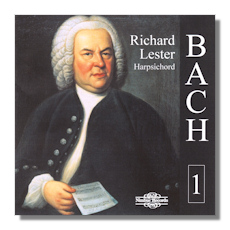
The Internet's Premier Classical Music Source
Related Links
-
Bach Reviews
- Latest Reviews
- More Reviews
-
By Composer
-
Collections
DVD & Blu-ray
Books
Concert Reviews
Articles/Interviews
Software
Audio
Search Amazon
Recommended Links
Site News
 CD Review
CD Review
Johann Sebastian Bach

Works for Harpsichord, Volume 1
- Goldberg-Variationen, BWV 988
- Italienisches Konzert in F Major, BWV 971
- Toccata in D Major, BWV 912
- Capriccio in B Flat Major "Capriccio on the Departure of the Beloved Brother", BWV 992
- Chromatic Fantasia & Fugue in D minor, BWV 903
- Sechs Kleine Präludien BWV 933-938
- Toccata in E minor, BWV 914
- Fantasia & Fugue in C minor, BWV 906
Richard Lester, harpsichord
Nimbus NI 5946/7
This is the first release of an extended project in which Richard Lester will record all of Bach's keyboard music for Nimbus. It's expected that two CDs will be issued each year from 2017 to 2023. From the very first bar of the "aria" of the Goldberg Variations, on the first CD in this first volume, the qualities of Lester's elegant and gently particular playing dispel any doubts which you may have as to whether there is room in the catalog for yet another such cycle.
Just as impressive as this refined and poised precision in the sonorous playing of Lester (who began his career in the early keyboard music movement in 1966) is an energy, albeit a balanced energy, which pulls you into the music. These qualities project new facets of what is probably familiar repertoire in a most stimulating way – though completely without spurious novelty. Lester invariably moves the music forward in a logical yet inspired manner, which excites the listener and invites them to anticipate what comes next. The result is that the differences between each of Bach's two and a half dozen variations are prominent, and stimulating.
Nimbus has opted for a recital approach, instead of working their way through Bach's keyboard œver chronologically or by type. This is likely to be just as attractive an option for those already familiar with the repertoire as it will be for anyone wanting to get a feel for how one distinguished player and expert in the field justifiably makes the music their own.
Lester approaches "early music" with its improvisatory qualities to the fore. Following qualities prized by his mentor Fernando Valenti (1926-1990), Lester brings freshness and invention to his performances - almost as though he were extemporizing himself for the first time. Listen to the (runs in the) "Canone all'Ottava" [CD.1 tr. 24]: there is nothing either wayward or haphazard. But these passages are spontaneous and heartfelt in their delivery in ways that only a performer who has internalized Bach's fancy and the essence of his idiom can understand. On most of the tracks Lester plays a two manual harpsichord by Colin Booth, which was derived from from a single manual harpsichord by Johann Christoph Fleischer from 1710… very like instruments which Bach knew. This instrument has a fluency – a light yet colorful fluidity – which facilitates the openness which Lester's playing demonstrates.
A side effect of this flexible approach is that we are made further conscious of the huge variety of Bach's achievement – and not only sonically or in terms of the instrument(s)' registers. For profundity stalks alongside humor. Climbing decorously up to sit next to sedateness are sweetness and wryness. Without appearing to have set out to find these qualities in Bach's keyboard music, Lester nevertheless draws them inexorably out, turns them over in his hands and offers them convincingly to us in an entirely appropriate contemporary style. At the same time, this recital has all the makings of a classic and enduring one.
The Italian Concerto BWV 971 [CD.2 tr.s 1-3] which opens CD 2 illustrates another aspect of Lester's playing: rigor. Strict adherence to the discipline and sense of movement in Bach's tempi and meters. Statement; counter statement; essential ornamentation; modulation; excursion – all underline the purpose of Bach's contrasts in dynamic where the Concerto Grosso distinguishes between solo and ensemble sonorities. The player here needs to keep sight of the melodic line; and not allow questions of structure such as rhythm to overpower that line. This Lester does admirably, reminding us of the freedom in control which performers like Wanda Landowska and George Malcolm showed.
Indeed, the phrasing of the Toccata in D Major BWV 912 [CD.2 tr.4] seems to delight Lester in extending and elevating this balance – between spontaneity and regulation… as surely Bach must have wanted. One result is that we are on the edge of our seats entering Lester's absorption in the logic of the music following him as he stretches it ever so slightly here and with a touch more liberality there. Similarly with the Chromatic Fantasia BWV 903 [CD.2 tr.s 11,12] and Preludes BWV 933-938 [CD.2 tr.13-18]. In short, he makes the familiar fresh, challenging and appetizing – which is one of the reasons why this series looks so promising, when considered alongside Lester's authority and the depth of his understanding of the ways in which this music was conceived and functions.
The acoustic in which these recordings were made affords the performances just the right amount of immediacy and presence. The miking is close so we get every nuance and subtlety. The booklet contains notes by Lester, and a commentary on each work which will provide just enough detail for anyone new to them. At a generous two and a half hours, this set makes a very promising beginning to an equally promising project from Nimbus and Lester. In the end - with so many competitive recordings of Bach's keyboard output - it will be Lester's felicitous blend of originality with sureness of hand, and vitality with perception that allow this first installment to be recommended without hesitation.
Copyright © 2017, Mark Sealey


















